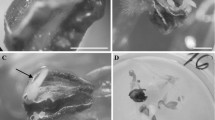Abstract
Cold pretreatment of detached tillers of rye, Secale cereale, was tested under two light regimes. The ryes included two spring and two winter cultivars. Significant increases in green plant regeneration were recorded in each experiment when cold pretreatments of two to four weeks were applied. Dim light during the stress period improved green plant regeneration for two of the four cultivars tested. The highest regeneration rate, 30.6 green plants per 100 plated anthers, was reached following three weeks at +4 °C under dim light, for spring rye Jo02. Starvation stress applied to plated anthers in mannitol medium suppressed anther response.
Similar content being viewed by others
References
Björnstad Å, Opsahl-Ferstad H-G & Aasmo M (1989) Effects of donor plant environment and light during incubation on anther cultures of some spring wheat (Triticum aestivum L.) cultivars). Plant Cell Tiss. Org. Cult. 17: 27–37
Chu CC, Wang CC, Sun CS, Hsu C, Yin KC, Chu CY & Bi FY (1975) Establishment of an efficient medium for anther culture of rice through comparative experiments on the nitrogen sources. Sci. Sinica 18: 659–668
Daniel G (1993) Anther culture in rye: Improved plant regeneration using modified MS-media. Plant Breed. 110: 259–261
Day A & Ellis THN (1985) Deleted forms of plastid DNA in albino plants from cereal anther culture. Curr. Genet. 9: 671–678
Deimling S & Geiger HH (1996) Anther culture in rye: Methodical improvements and genetic analysis. In: EUCARPIA, International Symposium on Rye Breeding & Genetics. Vortr. Pflanzenzüchtg. 35: 225–235
Flehinghaus T, Deimling S & Geiger HH (1991) Methodological improvements in rye anther culture. Plant Cell Rep. 10: 397–400
Flehinghaus-Roux T, Deimling S & Geiger HH (1995) Antherculture ability in Secale cereale L. Plant Breed. 114: 259–261
Friedt W, Lind V, Walther H, Foroughi-Wehr B, Züchner S & Wenzel G (1983) The value of inbred lines derived from Secale cereale_S. vavilovii via classical inbreeding and androgenetic haploids. Z. Pflanzenzüchtg. 91: 89–103
Heberle-Bors E, Stöger E, Touraev A, Zarsky V & Vicente O (1996) In vitro pollen cultures: Progress and perspectives. In: Mohapatra SS & Knox RB (eds) Pollen Biotechnology. Gene Expression and Allergen Characterization (pp 85–109). Chapman and Hall, New York
Hou L, Ullrich SE, Kleinhofs A & Stiff CM (1993) Improvement of anther culture methods for doubled haploid production in barley breeding. Plant Cell Rep. 12: 334–338
Immonen S (1999) Androgenetic green plants from winter rye, Secale cereale L., of diverse origin. Plant Breeding (in press) Immonen S & Anttila H (1996) Success in anther culture of rye. In: EUCARPIA, International Symposium on Rye Breeding & Genetics. Vortr. Pflanzenzüchtg. 35: 237–244
Immonen S, Tauriainen A & Manninen O (1999) Assessment of green regenerants from rye and triticale anther cultures. In: Clément C, Pacini E & Audran JC (eds) Anther and Pollen: From Biology to Biotechnology. Springer-Verlag Berlin Heidelberg, (pp. 237–245)
Jähne A & Lörz H (1995) Cereal microspore culture.Plant Sci. 109: 1–12
Mouritzen P & Holm PB (1994) Chloroplast genome breakdown in microspore cultures of barley (Hordeum vulgare L.) occurs primarily during regeneration. J. Plant Physiol. 144: 586–593
Murashige T & Skoog F (1962) A revised medium for rapid growth and bioassays with tobacco tissue cultures. Physiol. Plant. 15: 473–497
Powell W (1988) The influence of genotype and temperature pretreatment in barley anther culture response in barley (Hordeum vulgare L.). Plant Cell Tiss. Org. Cult. 12: 235–240
Rakoczy-Trojanowska M, Smiech M & Malepszy S (1997) The influence of genotype and medium on rye (Secale cereale L.) anther culture. Plant Cell Tiss. Org. Cult. 48: 15–21
Roberts-Oehlschlager SL & Dunwell JM (1990) Barley anther culture: Pretreatment on mannitol stimulates production of microspore-derived embryos. Plant Cell Tiss. Org. Cult. 20: 235–240
Sangwan RS & Sangwan-Norreel BS (1996) Cytological and biochemical aspects of in vitro androgenesis in higher plants. In: Jain SM, Sopory SK & Veilleux RE (eds) In Vitro Haploid Production in Higher Plants, Vol 1 (pp 95–109). Kluwer Academic Publishers, Dordrecht
SAS Institute Inc. (1993) SAS Technical Report P-243. SAS/STAT Software: The GENMOD Procedure, Release 6.09, SAS Institute Inc., Cary NC, USA.
Snape JW (1989) Doubled haploid breeding, theoretical basis and practical applications. In: Mujeeb-Kazi A & Sitch LA (eds) Review of Advances in Plant Biotechnology 1985–88. 2nd International Symposium on Genetic Manipulation in Crops (pp 19-30). Mexico, D.F., Mexico and Manila, Philippines: CIMMYT and IRRI
Touraev A, Indriato A, Wratschko I, Vicente O & Heberle-Bors E (1996) Efficient microspore embryogenesis in wheat (Triticum aestivum L.) induced by starvation at high temperature. Sex. Plant Reprod. 9: 209–215
Wang X & Hu H (1984) The effect of potato II medium for triticale anther culture. Plant Sci. Lett. 36: 237–239
Wenzel G, Hoffmann F & Thomas E (1976) Heterozygous microspore-derived plants in rye. Theor. Appl. Genet. 48: 205–208
Wenzel G, Hoffmann F & Thomas E (1977) Increased induction and chromosome doubling of androgenetic haploid rye. Theor. Appl. Genet. 51: 81–86
Wilde P (1996) Multi-stage selection for combining ability among pollen parent lines in hybrid rye breeding. In: EUCARPIA, International Symposium on Rye Breeding & Genetics. Vortr. Pflanzenzüchtg. 35: 15–25
Author information
Authors and Affiliations
Rights and permissions
About this article
Cite this article
Immonen, S., Anttila, H. Cold pretreatment to enhance green plant regeneration from rye anther culture. Plant Cell, Tissue and Organ Culture 57, 121–127 (1999). https://doi.org/10.1023/A:1006381516632
Issue Date:
DOI: https://doi.org/10.1023/A:1006381516632




